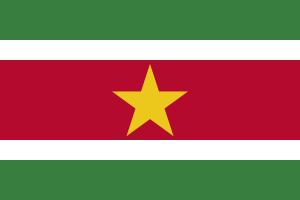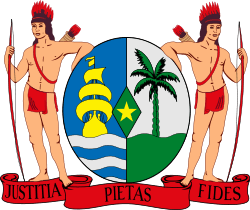Surinamese people
|
| |
| Total population | |
|---|---|
| c. 900,000 | |
| Regions with significant populations | |
| 570,000 | |
| 350,000[1] | |
| 3,000[2] | |
| 2,833[3] | |
| Languages | |
| Dutch, Sranan Tongo, English, Caribbean Hindustani, Javanese, Indigenous languages | |
| Religion | |
| Christianity (Roman Catholic, Protestants), Hinduism, Islam | |
Surinamese people are the citizens of Suriname and their descendants abroad. Suriname is a multi-ethnic nation, home to people of different ethnic and national backgrounds. As a result, Surinamese do not consider their nationality as an ethnicity but as a citizenship with various ethnicities.
Ethnic groups
The population of Suriname is a mixture of different ethnic groups:
- East Indians form 27% of the population. They are descendants of 19th-century contract workers from India. They are from the Indian states of Bihar and Eastern Uttar Pradesh, in Northern India, along the Nepali border.
- Africans form about 37% of the population, and are divided into two groups: the Creoles (15.7%), mixed descendants of West African slaves and Europeans (mostly Dutch), and Maroons (21.7%), descendants of escaped West African slaves. The two main Maroon groups are the Ndyuka and Saramaccans.
- Javanese (descendants of contract workers from the former Dutch East Indies on the island of Java, Indonesia),[4] form 14% of the population.
- Amerindians, the original inhabitants of Suriname, form 3.7% of the population. The main groups are the Akurio, Arawak, Kalina (Caribs), Tiriyó and Wayana. They live mainly in the districts of Paramaribo, Wanica, Marowijne and Sipaliwini.[5]
- Chinese, mainly descendants of the earliest 19th-century contract workers. The 1990s and early 21st century saw renewed immigration on a large scale. In the year 2011 there were over 40,000 Chinese in Suriname.[6]
- Europeans, descendants of Dutch 19th-century immigrant farmers, known as "Boeroes" (derived from boer, the Dutch word for "farmer"), Portuguese from Madeira and other European groups. Most Boeroes left after independence in 1975.
- Levantines, primarily Maronites from Lebanon, and Jews, mainly descendants of Sephardic Jews and Ashkenazi Jews. In their history, Jodensavanne plays a major role. Many Jews are mixed with other populations.
- Brazilians, many of them gold miners.[7] Most of the nearly 40,000 Brazilians living in Suriname arrived during the past several years.[8]
The seventh census of Suriname in 2004 reported the following:
- 27.4% East Indian,
- 17.7% Creole
- 14.7% Maroons
- 14.6% Javanese (Southeast Asians)
- 12.5% Mixed descent
- 3.7% Amerindian
- 3% Chinese
- 2% White
Population
Most of the inhabitants live in the north of the country, in the districts of Paramaribo, Wanica and Nickerie. The least populated county is Sipaliwini, which covers most of the nation's interior and is sparsely inhabited. More than half of the population lives in and around the capital.
Emigration
Migration to the Netherlands began during the colonial era. Initially this was mainly the colonial elite but expanded during the 1920s and 1930s to the less fortunate inhabitants looking for better education, employment, or other opportunities.[9]
Approximately 350,000 individuals of Surinamese descent now live in the Netherlands, with mass migration beginning in the years leading up to Suriname's independence in 1975, and continuing in the period immediately after independence and during military rule in the 1980s. Surinamese continued to migrate to the Netherlands throughout the 1990s because of the then tough economic situation in Suriname. Other emigration destinations include French Guiana and the United States.
Languages
In Suriname, there are no fewer than twenty languages spoken. Most Surinamese are multilingual. In terms of numbers of speakers are the main languages in Suriname, successively the Dutch language, Sranan Tongo (Surinamese Creole), Sarnami (Surinamese Hindi), Javanese, and different Maroon languages (especially Saramaccan and Ndyuka). In recent years, English is being spoken more and more by the majority of the younger populace. Since most Surinamese people are multilingual (for instance Dutch and Sranan Tongo), it is not easy for people to share in a particular language group.
According to the results of the seventh general population and housing census, which was held in 2004, Dutch is the most spoken home language in Suriname. In over 70% of households Dutch is spoken as the first or second language. The lingua franca is Sranan Tongo, which literally means "Surinamese language", and is spoken primarily as a second language in 46% of households, along with 22% Sarnami Hindustani and 11% Javanese.
Religion
The following religious statistics have been reported as of 2010:[10]
- 48% Christianity (25.2% Protestant and 22.8% Roman Catholic)
- 27.4% Hinduism (Sanatana Dharma and Arya Samaj)
- 19.6% Islam (Sunni)
- 1.3% Ahmadiyya
- 5% Indigenous or animist
References
- ↑ "The Netherlands and Suriname are closely linked". Government.nl. Retrieved 18 November 2011.
- ↑ "Surinamers op Aruba". Parbode. Retrieved 15 April 2015.
- ↑ "Table 1. First, Second, and Total Responses to the Ancestry Question by Detailed Ancestry Code: 2000". U.S. Census Bureau. Retrieved 4 July 2013.
- ↑ (Indonesian)Orang Jawa di Suriname (Javanese in Suriname), kompasiana. Access date:26 March 2011
- ↑ Joshua Project. "Joshuaproject.net". Joshuaproject.net. Retrieved 28 March 2010.
- ↑ Romero, Simon. "With Aid and Migrants, China Expands Its Presence in a South American Nation", The New York Times, 10 April 2011.
- ↑ "Violence erupts in Surinam". Radio Netherlands Worldwide. December 26, 2009.
- ↑ "Guyana: Caught in Brazil's Net?; Small Nation, New to Free Markets, Fears Loss of Its Identity". The New York Times. March 30, 2000.
- ↑ Gert Oostindie en Emy Maduro, In het land van de overheerser - II - Antillianen en Surinamers in Nederland 1634/1667-1954 (KITLV; Leiden 1986)
- ↑ Suriname: History, Geography, Government, and Culture Infoplease.com

